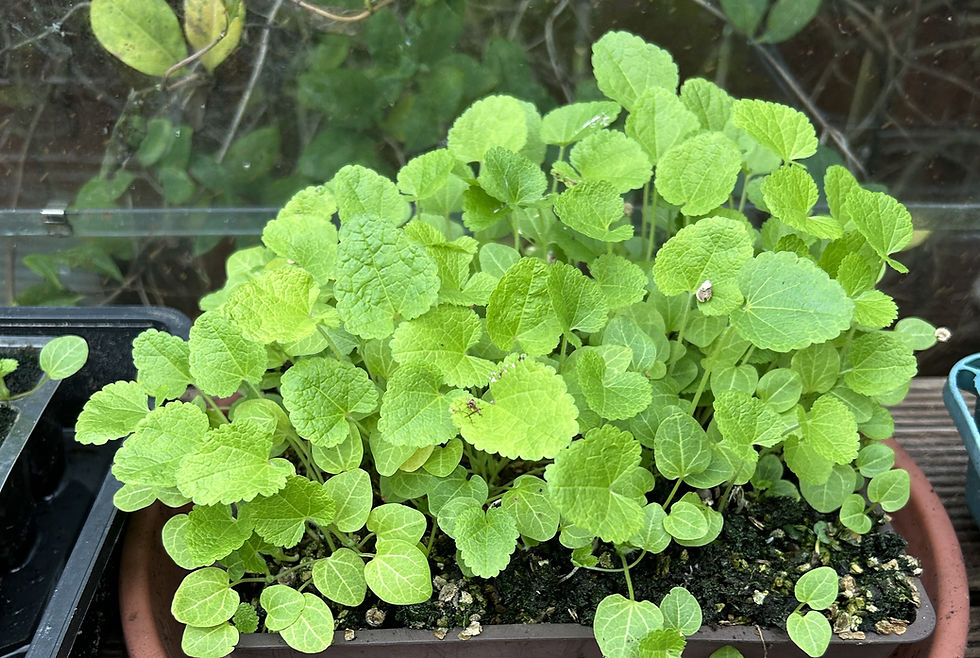Garden berries in December
- patrickwiltshire3
- Dec 14, 2023
- 4 min read

Cotoneaster tree Cotoneaster ‘Cornubia’ (pictured above) is an arching and spreading evergreen tree awash with attractive red berries appearing right across autumn and winter.
Why should gardeners get hold of Cotoneaster ‘Cornubia’?
Cotoneaster ‘Cornubia’ grows to about 3m tall in 10 years and acts as a perfect focal point to your garden. Cotoneaster ‘Cornubia’ is really hardy in our UK gardens, including here in East Yorkshire. It provides a year-long canopy of handsome, shiny leaves and lots of red berries too - a hit with local wildlife like garden birds.
What other advantages does this cotoneaster tree have?
Horizontal branches which means us gardeners only need one tree to fill a space 4-5m across. You could have an eye-sore for a view so a cotoneaster tree would fill this space quickly and effectively. The naturally arching stems will fill a space while the tree itself is not too large or imposing.
Will Cotoneaster ‘Cornubia’ survive in our cold UK gardens?
Yes this cotoneaster tree will survive happily in UK gardens given the correct soil. Cotoneaster trees can survive temperature dips to -20℃. These trees might lose some of their leaves in cold temperatures though they're readily replaced from the following spring.

I find cotoneaster trees look at their best covered in frost on a crisp, cloudless winter day with the leaves and berries set against a blue sky. Garden birds may eventually eat the berries but they prefer to take pickings from rowan, pyracantha and ornamental apples first.
When is a good time to plant cotoneaster trees?
Gardeners can plant cotoneaster trees as bare-root specimens in the winter or anytime of the year if the plant has been bought growing in a pot.
While these pot plants can go in the ground at any time I avoid planting in high summer or when the soil’s frozen in winter. This is to limit potential damage on the newly planted tree.
Grow contoneaster trees in any part of the garden. If in full-sun, keep an eye on the surrounding soil making sure it doesn’t dry out.
If bought as a bare-root (without soil around the roots) specimen
Choose a day when the soil isn’t frozen.
Choose a clear day (to keep spirits up more than anything).
Soak the roots in a large trug or bucket full of water while you prepare your planting hole.
Dig a hole to the depth of the height of the roots (you don’t want to force the roots into a shallow space. Yes, roots are naturally quite pliable, but they can snap if pressured too hard.)
While keeping your tree upright replace the soil around the roots in degrees, firming the soil with the back of your heel.
Once you’ve filled the planting hole your tree should stay in the ground when you give it a small tug. Place a ring of mulch around your tree and then water the area generously.
For the initial week to 10 days, water each morning. If there’s been no rain make this a fortnight.
If bought as a pot-plant
Pick a clear day when there’s little rain and when the soil’s not frozen.
Water the soil area of your pot plant if the soil surface is dry and/or dusty.
Dig a planting hole a little larger and as deep as the plant pot.
Remove your pot plant from the pot, keeping the soil area intact as much as you can.
Place your pot plant in the planting hole and keep it upright while filling the rest of the planting hole with the soil you took out. Spread any remaining soil around the bed or other beds if you need to.
For the initial week to 10 days water each morning. If there’s been no rain make this a fortnight.
I like contoneaster trees; can I make more of them?
The best way to propagate (make more of) cotoneaster trees is by taking semi-ripe cuttings from late summer and into autumn.
Cut 15cm of stem tips around your tree and pop each individual 15cm cutting in a plastic bag to encourage a closed humidity environment (to avoid stems drying out) before planting them up.
Take each cutting and prepare it for planting by snipping just just below the lowest leaf. Remove the next two leaves up.
Fill 9cm plant pots with seed and cuttings compost mixed with horticultural grit (if you can get your hands on it) to improve drainage. If you can’t, the cuttings compost on its own will do.
Prod a shallow hole in the centre of the compost in each pot and place your cutting within. Use your prodder (your finger, chopstick, dibber) to back fill in the hole with surrounding compost.
Pop the plant pots in a tray and water daily by filling the tray (rather than watering from above the leaves.) You can get rid of any excess water in the tray at the end of the day onto other plants in the garden.
Keep them in the ventilated greenhouse or in your home on a light windowsill. They’ll root more quickly in a soil that gets a bit of warmth so consider popping them in a heated propagator or above a radiator for a bit of the day.
What garden plants will accompany my tree cotoneaster?

Plant bulbs like crocuses, aconites (Eranthis hyemalis) and cyclamen (pictured above) under your cotoneaster tree. Daffodils contrast with what berries are left in March and April. The yellow flowers look super effective with the numerous red berries.



